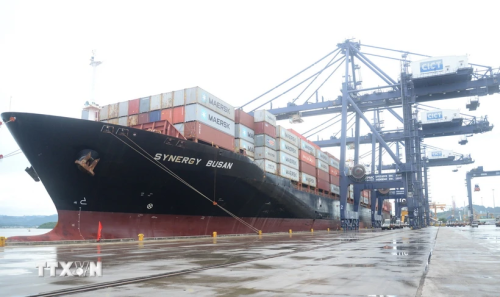As a deep-water port in the Hon Gai port cluster of Quang Ninh province, Cai Lan International Container Terminal has been invested with modern and synchronous infrastructure, playing an increasingly important role in the marine economic development strategy of Quang Ninh province in particular, and the economic development triangle of Hanoi - Hai Phong - Quang Ninh in a broader scope.
 |
| Unloading cargo at Cai Lan ICT (Photo: VNA) |
Thanks to its favourable location in a closed, deep water bay, with a nearly 600m long wharf, Cai Lan terminal can receive large ships with capacity of up to 5,500 TEU (85,000 DWT reduced load) without being limited by displacement like other ports. Fully aware of these potentials and advantages, in recent times, Quang Ninh province has paid special attention and given special priority to attract domestic and foreign resources for investment, and implemented synchronous and effective solutions to improve the quality of services in Cai Lan deep-water port. Accordingly, every year, channels into the wharfs are renovated and dredged; the system of machinery and facility for loading and unloading goods is modernised; warehouses and services are gradually standardised in accordance with international standards, etc. Moreover, the traffic system connecting Cai Lan terminal with economic centres, international border gates, has been developed in a synchronous, modern, and effective way, contributing to facilitating its operations, towards building a green seaport with effective use of coastline and surface resources. As a result, Cai Lan has become the closest port in the North for international container transit, one of the world's leading ports in Southeast Asia, and a "reliable address" for large shipping lines and domestic and foreign import and export agents.
With the active and flexible solutions for handling procedures for ships in and out the port, especially the application of digital transformation, improved capacity in loading and the enhancement of logistics services, etc., administrative procedures at Cai Lan International Container Terminal (CICT) have been simplified, implemented quickly, and ship docking time has been shortened. With 06 gantry cranes, a 14-hectare storage area equipped with Post Panamax wharfside cranes, Cai Lan Terminal has a loading and unloading capacity of 33 to 35 containers/crane/hour, and up to 40 containers/crane/hour at times. It just takes more than one day to unload a 5,000 TEU ship. This has brought much economic benefit for customers, increased ship efficiency, hence attracting more and more big ships in the world to the port. With a strategic vision, methodical approach, and effective investment, in June 2013, Cai Lan Terminal was the first port in the North to be granted CT PAT (C-TPAT) certificate by the US Customs - a standard of security and safety, allowing exports from Cai Lan ICT to come directly to the US. This is an important step in building Cai Lan into a world top 50 international standard terminal with increasingly modern and professional management and exploitation technology.
With improved service quality, efficiency and increased scale of operations, Cai Lan ICT is growing ceaselessly, making an important contribution to the development of Vietnam’s marine economy and the firm consolidation of national defence and security in the Northeastern sea of the country.
Cao Vuong